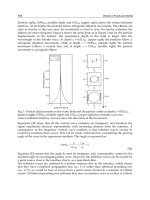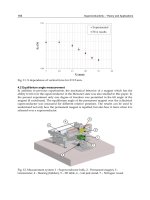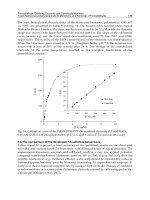Chapter 012. Pain: Pathophysiology and Management (Part 8) pptx
Bạn đang xem bản rút gọn của tài liệu. Xem và tải ngay bản đầy đủ của tài liệu tại đây (14.05 KB, 5 trang )
Chapter 012. Pain:
Pathophysiology and Management
(Part 8)
Antidepressant Medications
The tricyclic antidepressants [amitriptyline, imipramine, nortriptyline,
desipramine (TCAs; Table 12-1)] are extremely useful for the management of
patients with chronic pain. Although developed for the treatment of depression,
the tricyclics have a spectrum of dose-related biologic activities that include the
production of analgesia in a variety of clinical conditions. Although the
mechanism is unknown, the analgesic effect of TCAs has a more rapid onset and
occurs at a lower dose than is typically required for the treatment of depression.
Furthermore, patients with chronic pain who are not depressed obtain pain relief
with antidepressants. There is evidence that tricyclic drugs potentiate opioid
analgesia, so they may be useful adjuncts for the treatment of severe persistent
pain such as occurs with malignant tumors. Table 12-2 lists some of the painful
conditions that respond to tricyclics. TCAs are of particular value in the
management of neuropathic pain such as occurs in diabetic neuropathy and
postherpetic neuralgia, for which there are few other therapeutic options.
Table 12-2 Painful Conditions that Respond to Tricyclic
Antidepressants
Postherpetic neuralgia
a
Diabetic neuropathy
a
Tension headache
a
Migraine headache
a
Rheumatoid arthritis
a,b
Chronic low back pain
b
Cancer
Central post-stroke pain
a
Controlled trials demonstrate analgesia.
b
Controlled studies indicate
benefit but not analgesia. The TCAs that have been shown to relieve pain have
significant side effects (Table 12-1; Chap. 386). Some of these side effects, such
as orthostatic hypotension, drowsiness, cardiac conduction delay, memory
impairment, constipation, and urinary retention, are particularly problematic in
elderly patients, and several are additive to the side effects of opioid analgesics.
The serotonin-selective reuptake inhibitors such as fluoxetine (Prozac) have fewer
and less serious side effects than TCAs, but they are much less effective for
relieving pain. It is of interest that venlafaxine (Effexor) and duloxetine
(Cymbalta), which are nontricyclic antidepressants that block both serotonin and
norepinephrine reuptake, appear to retain most of the pain-relieving effect of
TCAs with a side-effect profile more like that of the serotonin-selective reuptake
inhibitors. These drugs may be particularly useful in patients who cannot tolerate
the side effects of tricyclics.
Anticonvulsants and Antiarrhythmics
These drugs are useful primarily for patients with neuropathic pain.
Phenytoin (Dilantin) and carbamazepine (Tegretol) were first shown to relieve the
pain of trigeminal neuralgia. This pain has a characteristic brief, shooting, electric
shock–like quality. In fact, anticonvulsants seem to be helpful largely for pains
that have such a lancinating quality. Newer anticonvulsants, gabapentin
(Neurontin) and pregabalin (Lyrica), are effective for a broad range of neuropathic
pains.Antiarrhythmic drugs such as low-dose lidocaine and mexiletine (Mexitil)
can also be effective for neuropathic pain. These drugs block the spontaneous
activity of damaged primary afferent nociceptors.
Chronic Opioid Medication
The long-term use of opioids is accepted for patients with pain due to
malignant disease. Although opioid use for chronic pain of nonmalignant origin is
controversial, it is clear that for many such patients opioid analgesics are the best
available option. This is understandable since opioids are the most potent and have
the broadest range of efficacy of any analgesic medications. Although addiction is
rare in patients who first use opioids for pain relief, some degree of tolerance and
physical dependence are likely with long-term use. Therefore, before embarking
on opioid therapy, other options should be explored, and the limitations and risks
of opioids should be explained to the patient. It is also important to point out that
some opioid analgesic medications have mixed agonist-antagonist properties (e.g.,
pentazocine and butorphanol). From a practical standpoint, this means that they
may worsen pain by inducing an abstinence syndrome in patients who are
physically dependent on other opioid analgesics.With long-term outpatient use of
orally administered opioids, it is desirable to use long-acting compounds such as
levorphanol, methadone, or sustained-release morphine (Table 12-1). Transdermal
fentanyl is another excellent option. The pharmacokinetic profile of these drug
preparations enables prolonged pain relief, minimizes side effects such as sedation
that are associated with high peak plasma levels, and reduces the likelihood of
rebound pain associated with a rapid fall in plasma opioid concentration.
Constipation is a virtually universal side effect of opioid use and should be treated
expectantly.









